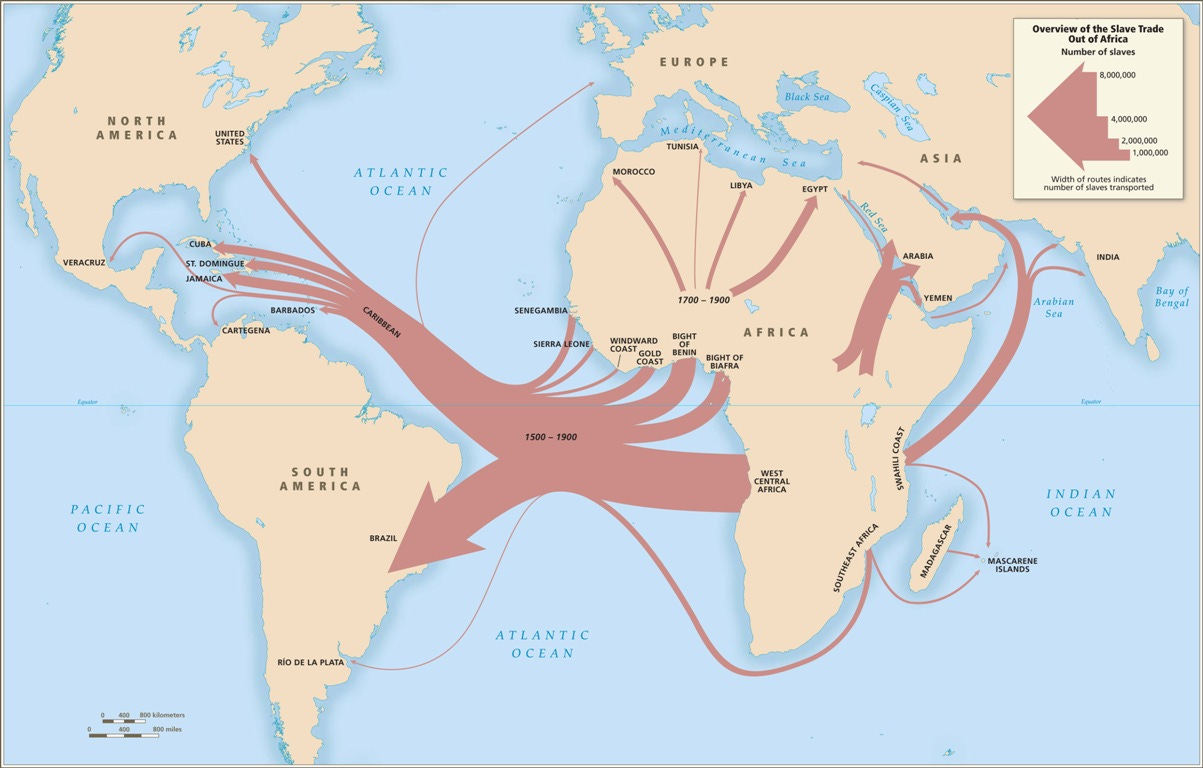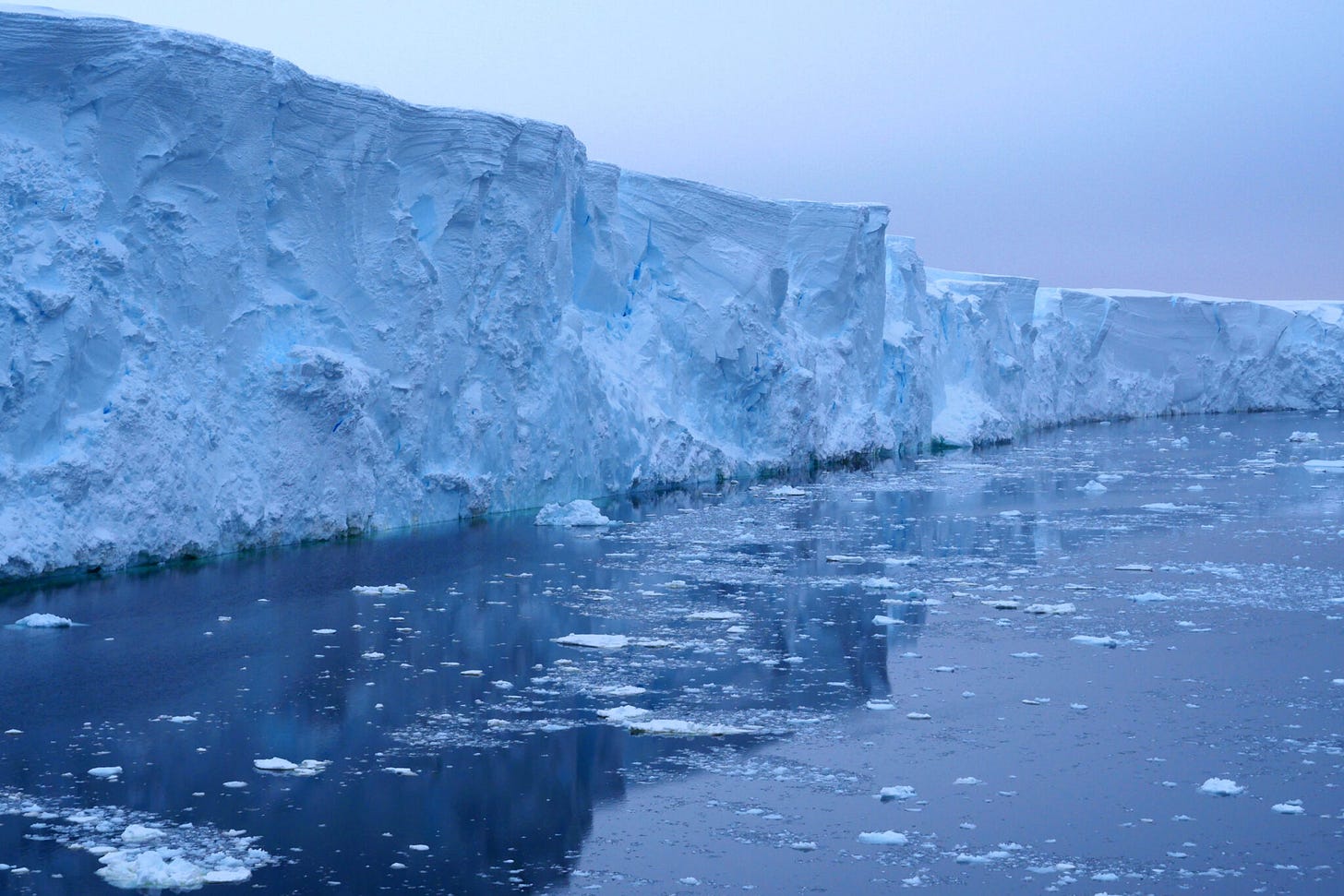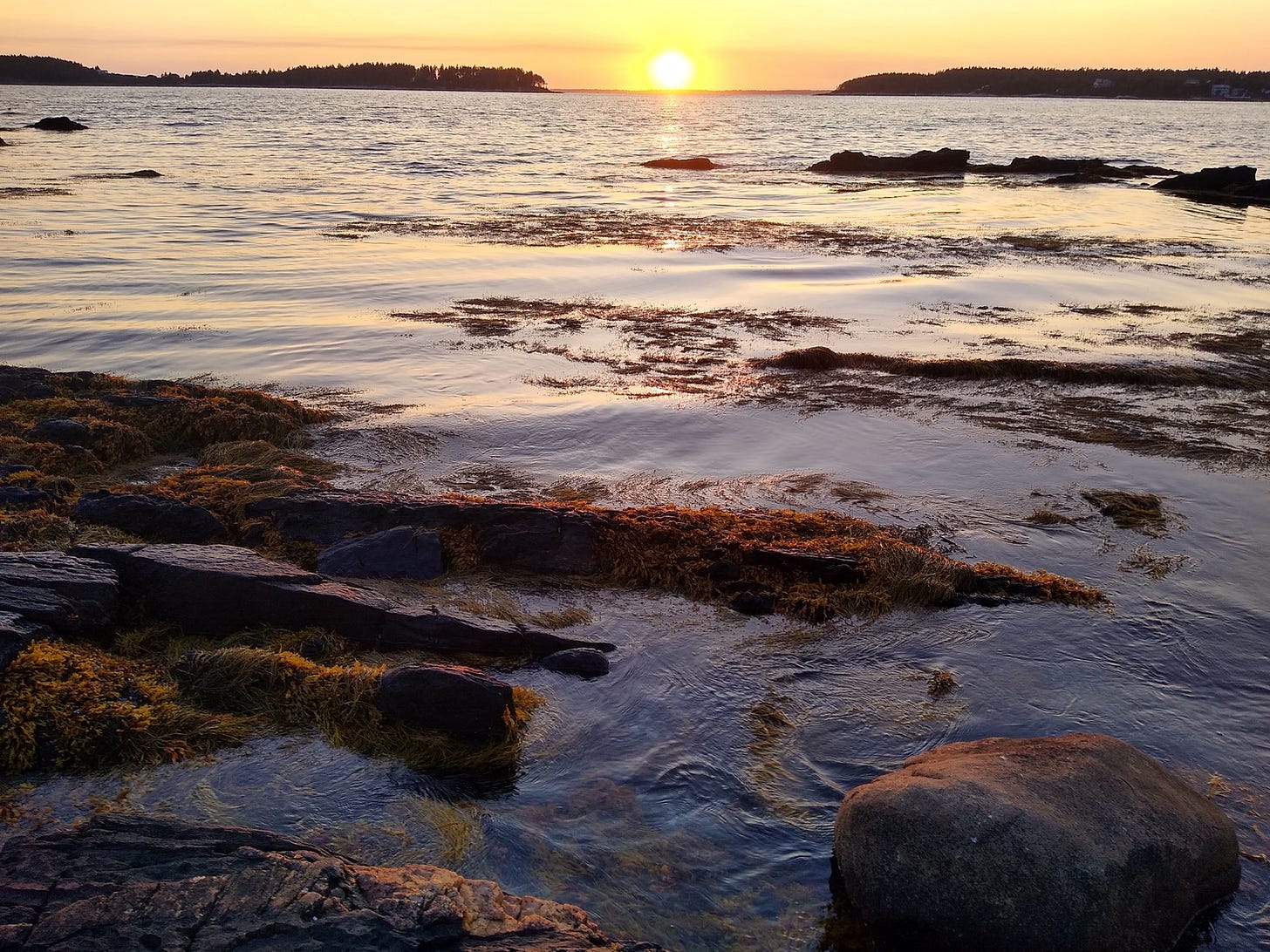Leveling Up
11/14/24 - finding our bearings
Hello everyone:
First, an apology. Last week I neglected to click the button I’ve clicked while launching every post over the last three and a half years, the button that says any subscriber can post a comment. (Substack’s default position is that only paid subscribers can comment.) Luckily, a thoughtful reader (thanks, Lor!) queried me about it. It’s been fixed now, so feel free to comment on “A River Runs Through Us” if you wish.
As always, please remember to scroll past the end of the essay to read some curated Anthropocene news.
Now on to this week’s writing:
Whenever I walk down to the sea here, as I often do, I’m comforted not by its permanence but by its restlessness. Gravity contains it in the bowl between continents, but it conveys both peace and power by singing in its chains (per Dylan Thomas) and, on occasion, by claiming the land as its own.
At a dinner party once, all of us gathered around the table, when it was my turn to describe my life in twenty words or less, I offered a rough sequence of places I’d called home since birth: Maine, Seattle, Maine, Cape Cod, Maine, Massachusetts, New Hampshire, Antarctica, New Zealand, Maine. With the exception of my years in college, I’ve always lived within a mile or three of the ocean. That proximity to restlessness is important to me.
Humans are desperately social creatures, but I think we’re equally attached to geography, each in our own way. We want to be loved, but we also want to be found, forever moving in self-conscious relation to place - Where am I? - and to each other - What am I to you?. Both questions are really asking Am I home? and Am I safe?.
We identify as a social/geographic binary, and have done since the earliest societies: the clan in the valley, the family in the village, the neighborhood in the city, the nation in the world. It’s as true for homebodies who stay where they were born as it is for children who move away to their chosen city. We pin our identity somewhere on the X-axis and Y-axis of who we are and where we live.
These twinned compasses of Who and Where have served the species well as we’ve spread across continents, vastly increased in number, and converted all the wild world into hypermapped possessions. Nothing exists outside our maps or claims. Even online we spend much of our time typing ourselves into digital clans. We know each other and ourselves by our maps.
The force of our mapping, though, can be as irrational as it is precise. One village in the valley gossips about the next, imagining differences. Eternal wars are fought over hastily-made borders. Entire societies and economies have been built around the delusion that skin color and gender signify morality and cognition. We name minor Martian craters no one will ever visit. We pledge allegiance to clan and country, people and politics, regardless of their actual values.
This loyalty to abstractions and symbols with which we map our identity, rather than to reality, is often the most dangerous aspect of culture.

The flags we wave are inherently meaningless scraps of cloth, but far too often we’ll imbue them with human meaning divorced from the common good and then proudly die on a hill in their name. Even worse are the flags that aren’t flags at all, only untethered ideas.
The plague of nationalism - a poisoned map drawn on a flag - is the religious urge writ political. Because the religious urge seems to be a feature of human consciousness, few things are more compelling and/or toxic to us than an abstract object imbued with sacredness. Because the meaning is applied rather than inherent, there’s no limit to the force of our belief.
We wave little flags every day, whether for teams, towns, or religious texts. The Christian nationalism poised to torque the executive branch of U.S. government (even more than it has already twisted the legislative and judicial branches) waves a host of little flags - e.g. anti-regulation, anti-immigrant, anti-environment - even though these ideas are neither Christian nor good for the nation.
Much of what I’m saying here is this: it’s human nature to mistake subjective notions for objective truths. We can see it in our identity maps - my team is the best team - and we can see it in innumerable weird cultural standards and measurements that we think are rational or even scientific. Two of my favorites are wind-chill, an exaggerated notion that measures only an approximate human perception of cold, and the seven-day week, which dates back a few thousand years to Babylonian astrology and has no basis in how time moves on Earth.
It’s not that subjective rationales aren’t useful; it’s that we have to remember their limits. In one of the places I called home - Antarctica - navigation was once extraordinarily difficult. The sun circles overhead, compasses uselessly point to a wandering magnetic south pole now far off the coast, and the converging lines of latitude at the geographic south pole - where every direction is North - make East and West into short strange curves that loop briefly across the empty ice cap until they meet back up with themselves. Before the advent of GPS, especially for aircraft, the solution was a grid mapping system, an artificial framework with four false cardinal directions. It’s an effective tool but relevant only in the isolated Antarctic context.
Elsewhere the tool is irrational, and any aircraft trying to navigate with it from the ice back to the warm world would assume a reality as unsafe as Christian nationalists in the White House using the New Testament as a fascist bludgeon.
When I’m standing by the ocean I don’t often think of sea level. I should care more about the rising sea than I do, because of its increasingly dire impacts on island nations and coastal cities. But so many other Anthropocene impacts are coming at us faster and harder. An anxious mind asks: What’s 4.5 millimeters per year of sea level rise compared to the droughts and fires in the Amazon, or the increasing extinction rate across the globe? Or, in the sea itself, what’s a few millimeters above compared to the ocean-wide impacts below: warming, acidification, deoxygenation, stratification, and slowing currents?
But it’s worth our time to contemplate the idea of “sea level.” The water’s edge is a liminal space, the threshold between terrestrial and oceanic life, and a physical plane that we’ve been culturally trained to think of as a stable reference point for measuring the tallest heights and the deepest depths.
The skin of the restless sea laps at our feet, roars against the shore, ebbs and surges twice a day in irregular patterns, expands and contracts according to temperature, bulges or flattens in relation to variations in gravity, retreats into or melts out of ice caps, and sings to the tune the winds play, yet for our convenience we’ve declared it a fixed object.
A fascinating recent New Yorker review of a new book, Sea Level: A History, notes that because of the Earth’s spin “the water levels of equatorial seas are some twenty-one kilometres higher than the sea ice at the North Pole,” and that a gravity anomaly drops part of the Indian Ocean 106 meters below the global average.
The quest to measure sea level as a benchmark for measuring the physical world began a couple centuries ago, ironically around the same time that we began to destabilize the physical world. Now, the notion of sea level no longer depends on wildly varying measurements from shorelines around the world. It is based on precise satellite readings and very complex calculations of “the geoid,” an imaginary wind- and tide-free ocean surface shaped only by Earth’s gravitational field.
But for all its precision, geoidal sea level is a fiction, a story that’s changing as the planet is changing under our influence. The 23 ft (7 m) of potential sea level rise in Greenland’s ice sheet, and the 200 ft (61 m) in Antarctic ice, make a mockery of the idea of a stable reference point. At best, sea level is an outdated snapshot now receding beneath the waves of the warming Anthropocene. I like the idea that the surface of the ocean is already above sea level…
Still, sea level is a deeply clever idea that soothes our anxious desire to know where we are on the planet - how else would we determine altitude? - but we cannot pretend it's an objective reality. According to the New Yorker article, sea level
is best thought of as a social and historical construct, the result of an inherently arbitrary decision taken by generations of people doing their best to make sense of a strange and chaotic world.
And that’s the reference point I want to leave you with: the strange and chaotic world. I don’t mean this as a dark commentary, just a reminder of the restlessness of things and how best to find our bearings within it. The insistence on fixed boundaries in either time or space on a dynamic, beautiful, living Earth is often a failure to observe reality.
The turbulent surface of the sea is the politics of wind and tide. Storms come and go. But the tempest of existence isn’t only oceanic. We live in an intertidal zone between past and future Earths. Terra firma is, in the big picture, as much a fiction as sea level. On a planet whose atmosphere spins up into whirlwinds, whose organic life churns through a multiplicity of floral and faunal forms, whose continents arise from and float on and disappear into a hidden sea of magma, we have to remain conscious of the inherent instability of the place we call home.
Better yet, we have to embrace a better role for ourselves within the tempests, even while recognizing that we are deeply irrational creatures with even more irrational social structures. We’re all gathered around the dinner table, telling stories about ourselves. Our identities are mere name tags in the whirlwind, but they’re also the stories we use to live a meaningful life. And the most meaningful life we can live right now, in this enormously difficult bottleneck in both human and Earth history, is to ground ourselves in the beautiful living world and work to reduce our harm to the rest of life.
The sea is rising, and we need to rise with it.
Thanks for sticking with me.
In other Anthropocene news:
From
, a new series of dispatches called Owl in America: Notes from an American environmentalist. In an echo of Heather Cox Richardson’s , and in the wake of the re-election of Donald Trump, Rebecca Wisent offers “a series of letters chronicling the next four years from the perspective of an environmental lawyer.”From Waging Nonviolence, “10 Ways to be Prepared and Grounded Now that Trump Has Won,” some much-needed advice “to avoid perpetuating the autocrat’s goals of fear, isolation, exhaustion and disorientation.”
From Slate, “The Renewable Energy Revolution is Unstoppable,” even with the next administration’s stated goal to cripple it where possible.
Another great and thoughtful piece from
at Chasing Nature, this one on observing sea ducks on a wintry Maine coast while contemplating the impact of the election on the natural world.From Orion, a deep and thoughtful dive into the collapse of fisheries in Denmark because of the nation’s industrial agriculture.
From Solutionary Rail, a long and fascinating explanation of the noble quest to electrify the nation’s rail system.
From SciDaily, a new study finds significant population declines in key plankton species from ocean warming and acidification.
From Inside Clean Energy, a fine personal essay wrestling with the idea of progress in the wake of the election.
From Yale e360, an update on progress in the desperate quest to breed corals better suited to survive in hotter seas.
From Anthropocene, energy grids powered by renewables are, contrary to public opinion, more reliable than those fueled by fossil fuels.








Lovely writing, and wise. Earth as ballast for sanity.
"The skin of the restless sea laps at our feet ..." is a reflection of not just a truth in action but the metaphor of our relationships and understanding. We are daily, often within moments, challenged by our binary selves.
There is a fascinating undertow within this piece that I look forward to resting with today.